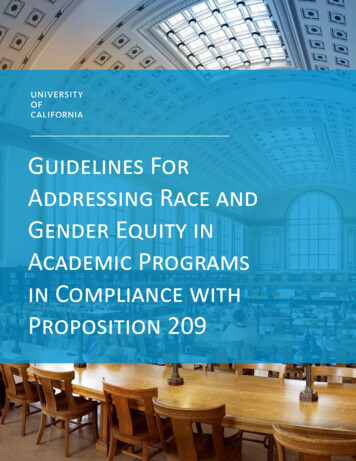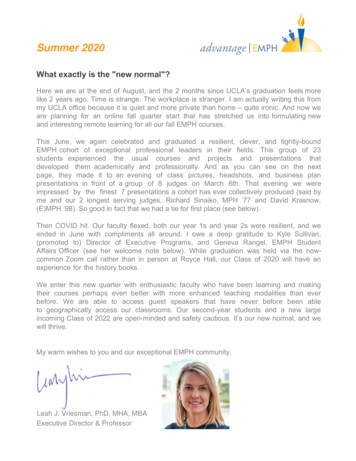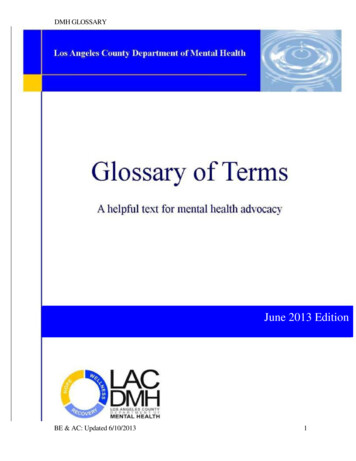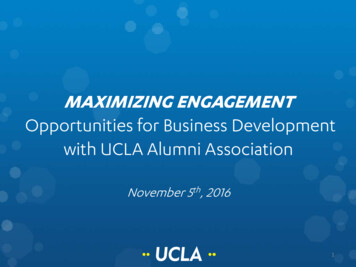
Transcription
Guidelines ForAddressing Race andGender Equity inAcademic Programsin Compliance withProposition 209
Table of ContentsUniversity of CaliforniaOffice of the General CounselGuidelines For Addressing Race and Gender EquityIn Academic Programs in Compliance with Proposition 209July 2015Special thanks toKaren J. Petrulakis, Chief Deputy General Counsel, Office of the General CounselSheila O’Rourke, Associate Campus Counsel, UC DavisElisabeth Yap, Senior Counsel, Office of the General CounselSusan Fogel, Senior Paralegal, Office of the General CounselGUIDELINES TO ENHANCING DIVERSITY.1UNDERGRADUATE DIVERSITY.6GRADUATE DIVERSITY.11FACULTY DIVERSITY .17ADDITIONAL TOPICS .23SUBJECT INDEX .26
General Guidelines For Enhancing DiversityIn September 2007, the University of CaliforniaBoard of Regents adopted a Diversity Statement calling on the University to “seek toachieve diversity among its student bodies andamong its employees” and acknowledging “theacute need to remove barriers to the recruitment,retention, and advancement of talented students,faculty, and staff from historically excluded populations who are currently underrepresented.” TheRegents’ commitment reflects dual institutionalgoals of diversity as inclusive excellence and diversity as equal opportunity. Diversity and equal opportunity support an academic community that reflectsa diverse range of interests, abilities, life experiencesand worldviews that will enhance the exploration ofideas vital to our academic mission. Diversity andequal opportunity also support UC’s legitimacy as apublic institution that serves our increasingly diversestate and nation, and fully utilizes the intellectualresources embedded in that diversity.UC President Janet Napolitano has renewed empha-1sis on how the University of California might continue its efforts to enhance diversity and equal opportunity, consistent with legal requirements prohibiting discrimination. Proposition 209, the 1996 voter initiative codified as article I, section 31 of theCalifornia Constitution, prohibits the University fromdiscriminating against or “granting preferentialtreatment” to any individual or group on the basisof race, sex, color, ethnicity or national origin.1While Proposition 209 eliminated some of the toolsthat the University had previously employed toachieve diversity in its student body and its workforce, there are many steps that the University cantake to maintain and enhance diversity and equalopportunity. The following guidance is intended as aresource for University administrators consideringmeasures that the University can legally implementto support the University’s commitment to diversity.There is separate guidance below addressing issuesspecific to undergraduate, graduate and faculty diversity. However, there are several general strategies that apply to all University diversity programs.For simplicity, these guidelines will refer to “race, color, ethnicity and national origin” collectively as “race.”Guidelines For Addressing Race and Gender Equity in Academic Programs1
Guidelines For Enhancing DiversityLeadershipThe commitment from University leadership is an important starting point forefforts to increase diversity. The UC Diversity Statement excerpted above that wasadopted by the Academic Senate and endorsed bythe President and the Board of Regents is an excellent example. Chancellors, Provosts, Deans andother university leaders also may express their support for diversity and equal opportunity throughtheir messages to the university community andthrough their commitment of resources. A boldmessage from the top can attract a diverse studentbody, engage a diverse faculty, promote a diversestaff, and create a welcoming campus climate.Strong leadership and active engagement can include high-level appointments for diversity leadership (for example, the UC San Diego Office of theVice Chancellor for Equity and Inclusion and the UCIrvine Vice Provost for Academic Equity, Diversityand Inclusion), statements of Principles of Community (see, for example, UC Riverside Principles ofCommunity and UC Merced’s Principles of Community), campus-wide strategic planning for diversity(for example, UCLA’s Strategic Plan for Diversity)and support for a broad range of diversity resources and initiatives (see, for example, UCLA’sDiversity @ UCLA website). Chancellors may convey the message through their conversations withcampus leaders, faculty, students and the broadercampus community. University leaders may express leadership by collaborating with philanthropic or civic organizations and by dedicating development officers to fundraising efforts earmarked fordiversity scholarships and programs. Strong leadership on diversity and equal opportunity can inspireinstitutional action at every level that will enhancethe University’s excellence in teaching, researchand service.Strong leadership on diversity and equal opportunity caninspire institutional action at every level that will enhancethe University’s excellence in teaching, research and service.Strategic Planning and Program EvaluationStrategic planning and program evaluationare additional important tools for engagingthe university community in support of diversity and equal opportunity. Campusesmay support campus-wide diversity strategic planning initiatives, such as UC Berkeley’s Strategic Planfor Equity and Inclusion. The collection and dissemination of data on the race and gender of students,employees, contractors, and of applicants for thosepositions complies with Proposition 209 and allowsthe University to determine the effectiveness of itsdiversity efforts. Campuses also may incorporatean evaluation of departments’ diversity efforts intotheir regular academic program review procedures.For example, the UC Berkeley Academic ProgramReview Guide Appendix VII provides an outline fora departmental strategic plan for equity and inclusion to be included in the self-study. Planning andevaluation support efforts to identify barriers thatmay be preventing the full participation of individuals from groups that have historically been underrepresented in higher education and to developeffective programs to address those barriers.Guidelines For Addressing Race and Gender Equity in Academic Programs2
Guidelines For Enhancing DiversityCampus ClimateThe UC Davis Principles of Community arean excellent expression of this commitment. Campuses can encourage and support speakers, discussions, and other educational events to discuss questions of affirmativeaction, diversity, and equal opportunity. Such discussions also may be effectively introduced on thecampuses via the curriculum in a broad array ofdisciplines. (See, for example, UC San Diego’s Diversity, Equity and Inclusion requirement.) Innovative approaches to teaching and research can support diversity and equal opportunity in the classroom, and can assist departments in diversifyingand strengthening their faculty. (For example, theAmerican Cultures Engaged Scholarship program atUC Berkeley.) Campuses may collaborate with andprovide routine assistance to private, nonUniversity organizations that provide benefits towomen and minorities in higher education. Maintaining an ongoing and civil dialogue on these issues can create a welcoming university environment for women and minorities and may also provide opportunities for input from a wide variety ofpersons, including the campus leadership, faculty,staff, students, and community members. Campuses may provide public and academic recognition toindividuals who make exceptional contributions toacademic and educational diversity through theirresearch, teaching, or service activities or to overallcampus climate. (For example, UC Berkeley supports the Chancellor’s Award for Advancing Institutional Excellence.)Each campus may promote diversity and equal opportunityby making every effort to provide a scholarly and educational environment that is welcoming and supportive of all participants, regardless of their race, color, ethnicity, or gender.Compliance with Non-Discrimination LawsEven under Proposition 209, the Universityhas an obligation to comply with State andFederal laws that prohibit discrimination,including harassment, on the basis of race,sex, color, national origin, and other protected categories. Campuses should ensure that there arereadily available resources for students, faculty,staff and other members of the campus communityto address concerns or complaints regarding equityissues. These resources should include policies andprocedures that provide protections against retaliation for individuals who file complaints. Each campus must comply with affirmative action regula-tions for federal contractors that apply to all employment programs. Federal affirmative action regulations and University policy require that all campuses develop and maintain a written affirmativeaction program covering staff, faculty, and all otheracademic employees. Maintaining a workplace andeducational environment free from illegal discrimination is both a legal obligation and an importantelement of the University’s efforts to promote diversity and equal opportunity. One campus, UCIrvine, collects these functions in a single office, theOffice of Equal Opportunity and Diversity, for acomprehensive approach.Guidelines For Addressing Race and Gender Equity in Academic Programs3
Guidelines For Enhancing DiversityCompliance with Proposition 209Although there remain unanswered questions about the interpretation of Proposition 209, it is clear that the Universitymay not use race or gender as a factor indeciding who will be granted admission or employment. This is different from federal law, which doespermit public universities to use race or sex as cri-teria to achieve diversity in some limited circumstances. Legal analysis of diversity programs underProposition 209 is often highly dependent on program specifics and details of implementation. Ingeneral, there are several strategies for diversityprogramming that are fully in compliance withProposition 209:Programs that are targeted by raceor gender but do not provide preferences or benefits that are not generally available to all.The University may, as part of a comprehensive program of outreach, target or increase specific efforts within that program toreach particular groups where the program’s benefits are available broadly to other groups, and the special efforts are necessary to reach the targeted group’s members effectively andtherefore to “level the informational playing field.” The University also may collect and evaluate data on the race or gender ofits students, employees, contractors and applicants in order todetermine the effectiveness of its diversity efforts, as reflectedin programs such as the federally mandated employment affirmative action plans and various approaches to strategic planningfor diversity and program evaluation.Programs that are not targeted byrace or gender but are targeted byfactors that support the University’sacademic mission and reflect theUniversity’s commitment to diversity and equal opportunity.The University may choose to advance its educational goals, including diversity and equal opportunity, by introducing or placing additional weight on a broad range of selection criteria whenmaking admissions and employment decisions. For example,holistic review in admissions considers factors such as incomelevel, first generation to attend college, neighborhood or community circumstances, disadvantages overcome, lowperforming secondary school attended, and the impact of anapplicant’s background and experiences on academic achievement. Selection for scholarships or employment may includeconsideration of factors such as ability to contribute to a diverseeducational or working environment and/or potential for leadership in increasing equitable access to higher education.Guidelines For Addressing Race and Gender Equity in Academic Programs4
Guidelines For Enhancing DiversityPrograms that are about issues relating to race or gender, but open toall.The University may support programs such as ethnic studies departments, workshops about women in science, speaker serieshighlighting the contributions of scholars of color, research institutes focused on race or gender issues, resource guides directedto the needs of individuals from a particular race or gender andretention efforts that address the barriers faced by women orminorities in higher education. The benefits of the programmust be available on a non-selective basis such that any interested individual, regardless of their race or gender, has access tothe same benefits.Programs that are targeted by raceor gender, but are operated andmanaged by private, non-Universityorganizations.Proposition 209 does not apply to private, non-University organizations, which may provide scholarships or other educationalbenefits targeted to women or underrepresented minorities.The University may provide routine assistance—such as information, incidental logistical support and access to campus facilities—to private organizations that target efforts on the basis ofrace or gender if (1) assistance is provided on a nondiscriminatory basis (that is, similar private organizations areeligible for similar assistance, regardless of the race or gender ofthe groups the private organization serves); (2) the Universitydoes not control or administer the private organization; and (3)the University is not involved in choosing recipients of the organization’s benefits.Programs that fall under an exception to the requirements of Proposition 209.Proposition 209 states that it shall not “be interpreted as prohibiting action which must be taken to establish or maintain eligibility for any federal program, where ineligibility would result in aloss of federal funds ” If there are university diversity programs that apply for or receive federal funds and must use raceor gender-based criteria to become or remain eligible for thefederal funding program, those programs are exempt fromProposition 209’s prohibition on granting preferences on thebasis of race or gender. Federal funding programs that requirepreferences based on race or gender are rare, so administratorswho believe preferential actions may be required in order toreceive the federal funding should consult with universitycounsel.Many examples of these strategies and programs are described in greater detail in these guidelines. However, these guidelines are not intended to be a substitute for legal advice. Administrators are encouraged toconsult with their campus diversity officers about program design and with their local campus counsel or theOffice of General Counsel on legal questions when considering specific practices. The University’s goal is tosupport diversity and equal opportunity programs, while minimizing legal risk and maintaining compliancewith applicable laws and University policies. Consulting early and often will help University administratorsachieve these objectives.Guidelines For Addressing Race and Gender Equity in Academic Programs5
Guidelines For Increasing the Diversity of theUndergraduate Student BodyThe University of California has long beenThough Proposition 209 prohibits the University fromcommitted to creating and maintaining angranting admissions or other preferences based onundergraduate student body that encomrace or gender (among other characteristics), the Unipasses the broad diversity of cultural andversity still may use numerous other strategies to culracial, as well as geographic and sociotivate a diverse undergraduateeconomic, backgrounds characteristicOpportunities to pro- student body, and particularly toof California. See Regents Policy 2101:increase the number of unmotediversityandPolicy on Undergraduate Admissions.derrepresented minority (URM)As recognized in Regental policy, suchequal opportunity exist applicants and students. Oppordiversity is critical to numerous educatunities to promote diversity andateachstepofastutional and societal interests. It broadequal opportunity exist at eachdent’spathtoenrollens and deepens the educational expestep of a student’s path to enrollrience and scholarly environment forment – and beyond, to ment – and beyond, to graduastudents and faculty alike, and it alsotion. As discussed in the Introducgraduation.furthers the University’s mission as ation above, certain baselinepublic institution to strengthen the someasures are effective and percial fabric of the State. In particular, a healthymissible in cultivating racial diversity in the undercampus climate, and the educational benefits itgraduate body, as in other University groups: collecbrings, depends on true diversity of the studenttion of data on program and policy outcomes relatingbody. The University has made significant effortsto the areas discussed below; evaluation of admisto ensure that applicants of all backgrounds havesions procedures to help eliminate barriers to URMequal access to the path to enrollment and thataccess or underutilization; compliance with federalstudents of all backgrounds have equal opportuniobligations relating to diversity; and routine assisty to benefit from and contribute to the Universitytance to private organizations’ diversity programs.during their time. See UC’s amicus briefs in FisherThe following are additional examples of measuresv. Univ. of Texas, et al. in 2012 and 2015 andaimed at undergraduate diversity more specificallySchuette v. Coalition to Defend Affirmative Action.that the University can take - and in many instancesalready has taken at some campuses – that are consistent with Proposition 209.Guidelines For Addressing Race and Gender Equity in Academic Programs6
Undergraduate DiversityLeadershipClear and continuous prioritization of diversity by Chancellors, deans, and other administrators is critical to fostering diversityamong the undergraduate student body.Strong statements of commitment to diversity bysuch individuals send an important message to thewhole University community, inspire actions thatpromote diversity, and help attract and retain diverse students. (For example, Chancellor Blumen-thal’s Message Regarding Diversity and Inclusion atUC Santa Cruz and Chancellor Yang’s Message onDiversity at UC Santa Barbara.) Likewise, strategicplanning relating to student diversity setting clearexpectations for diversity-related measures and outcomes helps create accountability for making progress in this area. (See UC Berkeley’s Strategic Planfor Equity, Inclusion, and Diversity.)Recruiting and Pipeline - Pre-offerOutreach targeted to potential applicantsbased on race or gender that offers only information available to all.Outreach targeted to potential applicants based on non-racial factors thatmay correlate with racial diversity.As part of a comprehensive approach to outreach,campuses may make special efforts to reach particulargroups if the same informational or other advantagesare broadly available to all through other avenues.Such targeted outreach may be necessary to effectively reach certain underrepresented groups and to ensure truly equal access to the University’s applicationprocess. For example, some campuses work with community organizations serving particular groups to shareinformation about the application process and attractapplications from that population. See, for example,UCLA’s SHAPE Project.Targeting outreach to potential applicants basedon a wide range of non-racial characteristics mayalso have the effect of increasing the racial diversity of the applicant pool. For example, outreachto students and communities based on the following characteristics may prove effective in increasing the racial diversity of the pool as well:residency in certain geographic areas; attendance at particular high schools (See, for example,high schools targeted by UCLA’s MECHA Xinachtliprogram and San Diego’s Talent Search); participation in community-based organizations withspecific racial/ethnic focus (See Santa Barbara’sSociety for Advancement of Chicanos and NativeAmericans in Science (SACNAS) and UCLA’s Latinas Guiding Latina’s; socio-economic disadvantage (See Irvine’s Upward Bound); residencyin public housing; single-parent home; farmworker parents; and former foster children (SeeRiverside’s Guardian Scholars Program). Outreach efforts may include, for example, visits totargeted schools and inviting targeted groups tovisit particular campuses and to apply for admission.Guidelines For Addressing Race and Gender Equity in Academic Programs7
Undergraduate DiversityOutreach programs that may be of particularinterest to URM communities.Assistance to external organizations’URM-targeted outreach.As long as they are open to all participants, regardlessof their race or gender, the University may offer outreach, informational, and other programs that may,because of their content, be of particular interest tomembers of a particular racial group or gender. Forexample, campuses may invite applicants to programs addressing “the African American experienceat UC” or “Women’s Issues at UC.” See, for example,Davis’s Black Family Day.Organizations that are not bound by Proposition209 may directly target their efforts to recruitapplicants based on race or gender. Though itmay not do so itself, and may not select individuals to participate in such external programs,the University may provide routine assistance tosuch organizations, for example providing information or facilities for them to use in outreachactivities, on the same terms it does for othersimilar organizations.The University is committed to tapping the broaddiversity of California’s community collegesthrough transfer admissions.Programs aimed at increasing transfers fromcommunity colleges.The University is committed to tapping the broad diversity of California’s community colleges throughtransfer admissions. See Preparing California For ItsFuture – Enhancing Community College StudentTransfer to UC. Also see Berkeley’s Starting PointMentorship Program, Irvine’s Explore Science on Saturdays (eSOS) and UCLA’s Center for Community College Partnerships. In particular, the student body ofthe California community college system is more racially and ethnically diverse than the University’s, andincreasing transfers from the former may increasediversity of the latter. The University’s efforts todeepen its relationships with the full range of community colleges and to simplify the transfer process isan opportunity to increase the racial diversity of itsstudent body.K-12 pipeline activities.Initiatives aimed at improving the academic preparation and college readiness of students in certain communities (for example, low-performingschools) may ultimately increase the diversity ofthe applicant pool for the University and moreeffectively address barriers to equal educationalopportunity through earlier intervention. See, forexample, UCLA’s SMARTS Program, Santa Barbara’s Pathways to College and the Puente Project at UC Berkeley.Guidelines For Addressing Race and Gender Equity in Academic Programs8
Undergraduate DiversityAdmissions Process and CriteriaContinued and rigorous use of holistic review.The campuses use admissions criteria that look beyond traditional measures such as grades to moreholistic ones that allow for consideration of an applicant’s life experiences more generally. These factorsinclude, for example, neighborhood and communitycircumstances and disadvantages overcome. Admissions readers should continue to be trained to givesuch factors appropriate weight. Emphasis on applying a broad range of admissions criteria may help theUniversity attain greater racial diversity while maintaining or increasing its academic rigor.Use of racial or gender demographics as one ofseveral criteria.The University may grant special considerationto students from, for example, particular highschools or neighborhoods based in part on theoverall ethnic demographics of the school orneighborhood, as long as the University doesnot differentiate among applicants on the basisof their individual race.Yield Activities - Post-OfferOutreach targeted to parents of URM prospects.The University may conduct outreach aimed specifically at parents of URM students, to offer information that is available to all. Such efforts could include, for example, phone calls, letters, or meetingsto persuade URM prospects to enroll, without offering additional benefits to the students. Such effortsmay nonetheless be effective in demonstrating theUniversity’s interest in serving URM students andbuilding relationships with their families and communities.Targeted resource guides for URM prospects.As part of a comprehensive program of outreach,the University may target or increase specificefforts to reach URM prospects. (See, for example, Black Book UC Santa Barbara.) Such effortsmay be necessary to effectively reach certaingroups or to level the informational playing field.Though such guides may be of particular interestto URM prospects, the information must be available to all interested individuals, regardless ofrace.Outreach targeted to prospects based on non-racialfactors that may correlate with racial diversity.As with pre-offer outreach (see above), targetingpost-offer outreach to prospects based on certainnon-racial characteristics, such as residency in certain geographic areas, may serve to increase racialdiversity as well.Assistance to external organizations’ URMtargeted outreach.Outreach programs that are run by non-Universityentities that are not bound by Proposition 209may limit participation exclusively to URM prospects. For example, outside entities may providefunding directly to URM prospects to enhanceUniversity outreach, such as assistance with travelcosts to attend University outreach programs.The University may provide routine assistance tosuch entities by, for example, providing lists of allconsenting students with the desired characteristics, as long as it is not involved in selecting students to participate in these externally-run programs.Outreach programs that may be of particular interest to URM prospects.The University may offer programs focusing on information of particular interest to URM prospects - forexample, a weekend program about the AfricanAmerican experience at the campus– as long as theyare pen to all content, regardless of race. (See, forexample, ACE at UC Davis, PIER at UCLA and the activities of San Diego’s UJIMA Network.)Guidelines For Addressing Race and Gender Equity in Academic Programs9
Undergraduate DiversityFinancial Aid and OtherFunding StrategiesSupport of scholarships for URM students that are funded by external sources.Though Proposition 209 prohibits the University frombasing funding decisions on a student’s race or gender, itmay provide assistance to non-University organizationsthat are not restricted in this manner. For example, theUniversity may provide information, incidental logisticalsupport, and access to campus facilities. Such assistanceshould be provided on a non-discriminatory basis, to organizations that are independent of the University, andthe University should not be involved in selecting recipients of the funding. For further details, see Financial AidGuidelines For Compliance With Proposition 209.Funding targeted at students from particular local highschools.As discussed above, the University may consider the racial or gender demographics of a school in deciding howto allocate its resources, as long as it does not consideran individual student’s race or gender. Targeting fundingassistance for schools with certain demographic profilesmay open access to a more diverse pool of prospects.Funding targeted at students with the potential forleadership in diversity.The University may award funds to students who arelikely to advance its commitment to diversity throughdemonstrated leadership on this issue, irrespective of astudent’s individual race. Such funding will help attractstudents with the interest and capacity to contribute tothe University’s diversity efforts.RetentionUniversity-run retention programs aimed at studentsfrom disadvantaged backgrounds, or based on othernon-racial factors that may correlate with racial diversity.Specifically targeting academic support services andother retention strategies to students from low-incomeor otherwise disadvantaged backgrounds, or based onother characteristics that may correlate with racial diversity, may also help to maintain racial diversity in thestudent body. See SAGE Scholars, Berkeley, SAGE Scholars, Irvine and Berkeley’s Multicultural Immigrant Student Program.Retention programs focused on the experience of URMstudents but open to all.The University or student groups may provide supportservices that focus on the experience of URM students,to increase their chances of success at the University, ifthose services are open to all students. (See, for example, programs under the umbrella of UC Davis’s StudentRecruitment and Retention Center and UCLA’s StudentRetention Center.)Assistance to external organizations’ URM-targetedretention programs.Retention programs run by non-University entities thatare not bound by Proposition 209 may limit participation exclusively to URM students, and the Universitymay provide routine assistance to such entities.Campus ClimateCampus climate is critical to attracting and retaining all students, and URM students particularly. The University is committed to creatingan environment of respect and inclusion (seeUniversity of California study results and summaries ofrecent campus climate efforts: An Ethos of Respect andInclusion) and to
Strategic Planning and Program Evaluation S trategic planning and program evaluation are additional important tools for engaging the university community in support of di-versity and equal opportunity. ampuses may support campus-wide diversity strategic plan-ning initiatives, such as U erkeley’s










